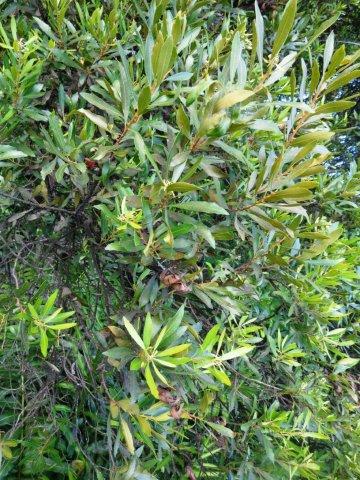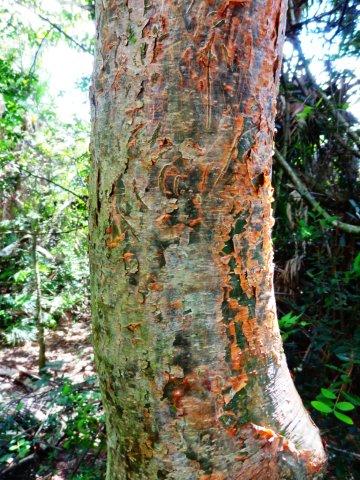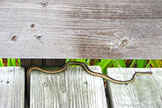QR Zones of Green Cay Wetlands Boardwalk
Back to Introduction

 Follow this link to see a video presentation of this zone!
Follow this link to see a video presentation of this zone!
The tropical hardwood hammock is located in an area of slightly higher elevation than the surrounding wetland and is characterized by hardwood forests of broad-leaved evergreen trees and shrubs. These areas are scattered throughout the Everglades, and the dense, vine-entangled tropical hardwood hammock looks like a tiny islands dotting the marsh landscape. Tropical hardwood hammocks date back thousands of years to when coral reefs were exposed by receding water levels. The tropical hardwood hammock is a self-maintaining community that usually remains untouched by fire or flood. These islands can support more than 20 species of tropical trees, shrubs, and vines, and provide critical habitat for numerous animals.
Trees: Paurotis/Everglades Palm, Gumbo Limbo, Satinleaf, Strangler Fig, Royal Palm, Paradise Tree, Wild Lime.
Understory: Simpsons Stopper, Marlberry, Corky Passionvine, Sugarberry, Red Bay, White Stopper, White Indigo Berry, Fakahatchee Grass, Spanish Stopper, Firebush, Red Mulberry, Wax Myrtle.

WAX MYRTLE - A wispy, 6-12 ft., multi-trunked, evergreen shrub, southern bayberry or wax myrtle can reach 20 ft. in height. The light olive-green foliage has a spicy fragrance. Pale blue berries occur on female plants in the winter. Handsome gray bark is almost white on some plants. Native from New Jersey west to eastern Oklahoma and east Texas, south through Mexico to Central America as well as through much of the Caribbean, this popular evergreen ornamental is used for screens, hedges, landscaping, wetland gardens, habitat restoration, and as a source of honeyThe leaves are aromatic, with an appealing, piquant fragrance when crushed. Colonists separated the fruits waxy covering in boiling water to make fragrant-burning candles, a custom still followed in some countries.

ROYAL PALM - Royal Palm trees are common in nearly every Florida tropical hammock. They are native to Florida and are commercially important to the landscaping industry in the coastal South. Roystonea is the genus name of eleven species of palms which includes royal palm. The royal palm is native to the Caribbean Islands, and the adjacent coasts of Florida, Central and South America. It is one of the most recognizable and commonly cultivated palms in tropical and subtropical regions and considered by many to be the most beautiful palm in the world.

GUMBO LIMBO - This large semievergreen tree, with an open, irregular to rounded crown, may reach 60 feet in height with an equal or wider spread but is usually seen smaller (25 to 40 feet tall and 25 to 30 feet wide) in landscape plantings. The trunk and branches are thick and are covered with resinous, smooth, peeling coppery bark with an attractive, shiny, freshly-varnished appearance. The tree typically develops from two to four, large-diameter limbs originating close to the ground. A native of south Florida and the tropical offshore islands, the soft, light-weight and easily carved wood of gumbo-limbo was used for making carousel horses before the advent of molded plastics. The gumbo-limbo is comically referred to as the Tourist Tree because the tree's bark is red and peeling, like the skin of sun-burnt tourists, who are a common sight in the plant's range.

STRANGLER FIG - This plant starts out as an epiphyte and attaches to a host tree, usually a cabbage palm. The strangler fig sends out roots that tangle around the host and eventually strangles it. Still the strangler fig fills an important niche and food source to many tropical forest hammock creatures. Many forms of life are attracted to the fig tree because of its production of large amounts of fig fruits and can be the only source of food during certain seasons.

FIREBUSH - Firebush is a large, soft-stemmed shrub that reaches a height and width of 8 to 12 feet. Bright orange-red flowers appear at the tips of the branches throughout the year. The slender flowers are tubular and grow 1 to 1 ½ inches long. Hummingbirds and butterflies enjoy the nectar of the Firebush while the small, black, glossy fruits they produce are a staple food source for many birds. Despite the ominous name, this plant is not poisonous. In fact, the sap has historically been used to treat skin rashes.

ELDERBERRY - American elder, or elderberry, is a bush shrub that grows to be around 10 to 15 ft. In most regions, elderberry flowers are produced throughout the spring and summer, but in much of Florida there are some elderberries in bloom every month of the year. The berries are highly edible by over 50 different species of birds. The flowers of American elder are used to make elderflower water which is used in perfumes, confectioneries and a pale champagne-like wine. Raw elderberries have an unpleasant taste and contain small amounts of poisonous alkaloids, which can be destroyed by cooking and made into pies, jellies, and of course, elderberry wine. Elderberries have more vitamin C per unit weight than oranges or tomatoes. Historically, Native Americans made much use of the American elder. They used the bark, flowers and fruits for medicines; and they made cakes, puddings, breads and drinks from the berries.

SNAKES - Many species of snakes can be seen swimming through the grasses of the shallow marsh water hunting for food. Most notably: the Peninsular Ribbon Snake and the Brown Banded Water Snake. The Peninsular Ribbon Snake (pictured) is a unique species in two ways: first, they are one of the very few snake species that gives birth to live young and second, they eat only cold blooded prey such as fish, tadpoles, and small invertebrates. The Brown Banded Water Snake can oftentimes be mistaken for the venomous Water Moccasin. Neither the Ribbon nor the Water Snakes are venomous and are important members of the marsh ecosystem food web, being both a predator and an important food source for large wading birds such as herons.
Green Cay Nature Center and Wetlands is owned and operated by the
Palm Beach County Parks and Recreation Department and the
Water Utilities Department.